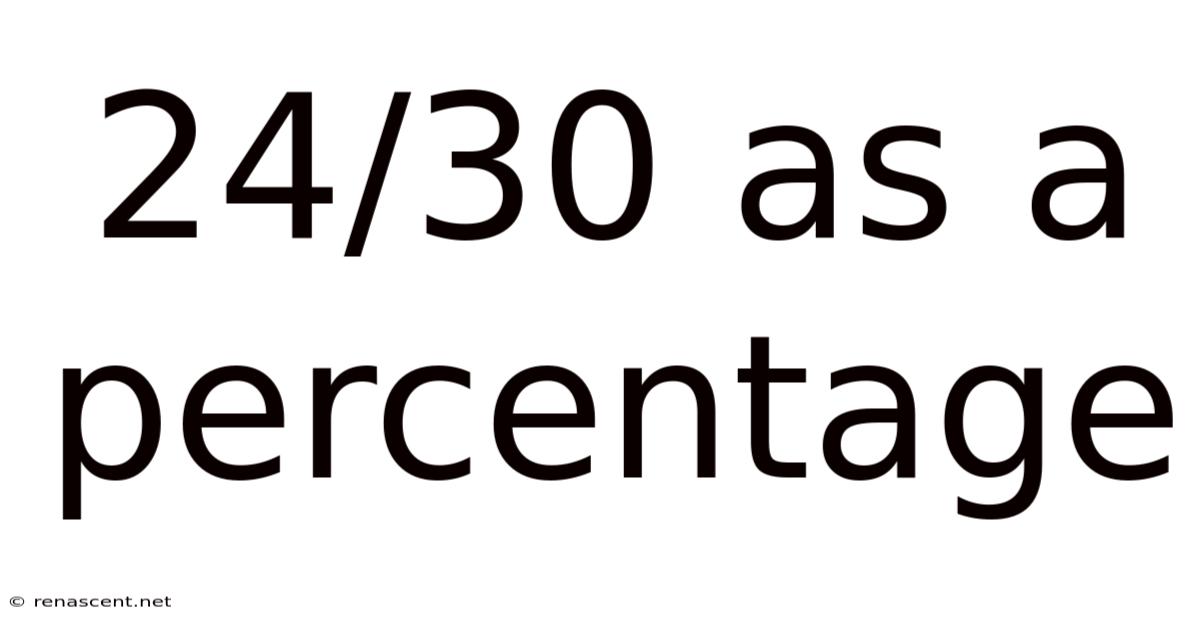24/30 As A Percentage
renascent
Sep 23, 2025 · 5 min read

Table of Contents
24/30 as a Percentage: A Comprehensive Guide
Converting fractions to percentages is a fundamental skill in mathematics with applications spanning various fields, from calculating grades in school to understanding financial data. This comprehensive guide will walk you through the process of converting the fraction 24/30 into a percentage, explaining the underlying principles, providing multiple methods for calculation, and exploring related concepts to deepen your understanding. We'll also cover common applications and answer frequently asked questions. Understanding this simple conversion is key to mastering more complex percentage problems.
Understanding Fractions and Percentages
Before diving into the conversion of 24/30, let's establish a clear understanding of the terms involved. A fraction represents a part of a whole. It consists of a numerator (the top number) and a denominator (the bottom number). In the fraction 24/30, 24 is the numerator and 30 is the denominator. This means we are considering 24 parts out of a total of 30 parts.
A percentage, denoted by the symbol %, represents a fraction out of 100. It expresses a proportion as a number out of 100. For example, 50% means 50 out of 100, or 50/100, which simplifies to 1/2. Percentages are widely used because they provide a standardized way to compare proportions.
Method 1: Direct Conversion Using the Formula
The most straightforward method to convert a fraction to a percentage involves a simple formula:
(Numerator / Denominator) x 100%
Applying this formula to the fraction 24/30:
(24 / 30) x 100% = 0.8 x 100% = 80%
Therefore, 24/30 is equivalent to 80%.
Method 2: Simplifying the Fraction First
Before applying the formula, simplifying the fraction can make the calculation easier. We can simplify 24/30 by finding the greatest common divisor (GCD) of 24 and 30, which is 6. Dividing both the numerator and the denominator by 6, we get:
24 ÷ 6 = 4 30 ÷ 6 = 5
This simplifies the fraction to 4/5. Now, we apply the formula:
(4 / 5) x 100% = 0.8 x 100% = 80%
This confirms that 24/30, when simplified, also equals 80%. Simplifying first can be particularly helpful when dealing with larger numbers.
Method 3: Using Decimal Conversion
Another approach is to first convert the fraction into a decimal and then multiply by 100%. Dividing the numerator by the denominator:
24 ÷ 30 = 0.8
Then, multiply the decimal by 100%:
0.8 x 100% = 80%
This method is efficient and easy to understand, especially when using a calculator.
Understanding the Meaning of 80%
Achieving an 80% score on a test, for example, means you correctly answered 80 out of every 100 questions. In the context of 24/30, it signifies that you successfully completed 24 tasks out of a total of 30. This represents a strong performance, indicating a high level of accuracy or achievement.
Real-World Applications of Percentage Conversions
The ability to convert fractions to percentages is invaluable in numerous real-world scenarios:
- Academic Performance: Calculating grades based on correctly answered questions or assignments.
- Finance: Determining interest rates, calculating discounts, understanding profit margins, and analyzing financial statements.
- Statistics: Representing data proportions in charts and graphs, analyzing survey results.
- Science: Expressing experimental results, calculating concentrations of solutions.
- Everyday Life: Calculating tips, understanding sales taxes, comparing prices.
Beyond the Basics: Working with More Complex Fractions
While 24/30 is a relatively straightforward example, the principles discussed here apply to more complex fractions. Even if the fraction doesn't simplify easily, the fundamental formula remains the same: (Numerator / Denominator) x 100%. You can use a calculator to perform the division if needed.
For fractions with decimal numbers in the numerator or denominator, the process remains similar. The key is to perform the division accurately before multiplying by 100%.
Frequently Asked Questions (FAQ)
Q: What if the fraction is an improper fraction (numerator larger than the denominator)?
A: The same method applies. The resulting percentage will be greater than 100%. For example, 35/30 would result in a percentage greater than 100%.
Q: Can I convert percentages back to fractions?
A: Yes! To convert a percentage to a fraction, divide the percentage by 100 and simplify the resulting fraction. For example, 80% becomes 80/100, which simplifies to 4/5.
Q: Are there any online tools or calculators to help with these conversions?
A: Yes, many websites and apps provide fraction-to-percentage calculators. These can be helpful for double-checking your calculations or for working with more complex fractions.
Q: Why are percentages so widely used?
A: Percentages provide a standardized way to compare proportions. They make it easy to understand and compare different values, regardless of the total number of items or units involved.
Conclusion
Converting 24/30 to a percentage is a simple yet crucial skill with far-reaching applications. By mastering this conversion, you are not only improving your mathematical proficiency but also enhancing your ability to interpret and utilize data effectively in various real-world situations. Whether you use the direct formula, simplify the fraction first, or convert to a decimal, the result remains the same: 24/30 is equivalent to 80%, representing a significant portion of the whole. Remember to practice consistently to build fluency and confidence in your calculations. Understanding percentages is a foundational skill that will continue to be valuable throughout your life and across many different disciplines.
Latest Posts
Latest Posts
-
1 12 As A Decimal
Sep 23, 2025
-
Dr Catherine Harris Medicare
Sep 23, 2025
-
Histogram Or Bar Graph
Sep 23, 2025
-
Square Root Of 216
Sep 23, 2025
-
Gcf 15 And 25
Sep 23, 2025
Related Post
Thank you for visiting our website which covers about 24/30 As A Percentage . We hope the information provided has been useful to you. Feel free to contact us if you have any questions or need further assistance. See you next time and don't miss to bookmark.